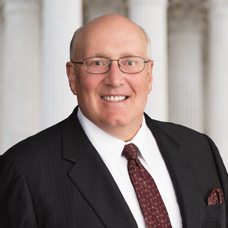“The time for kicking the can down the road is rapidly coming to a close. The Supreme Court will eventually have the right petition before it, without the safe harbor of the forfeiture rule applied by the Federal Circuit, and will have to squarely address the merits head on of the Appointments Clause and how PTAB judges were and are appointed.”
 On April 6, Arthrex, Inc. filed a petition for certiorari in the U.S. Supreme Court on two discrete patent issues. Notably, one of the issues raised in Arthrex’s April 6 petition is likely to prove especially compelling to the Supreme Court, and may well tilt the balance for it being granted, as it provides an inroad to a constitutional Appointments Clause issue that is central to several other petitions by various parties on the same issue. Arthrex is widely anticipated to file another petition for certiorari on this issue stemming from the Court of Appeals for the Federal Circuit’s recent denial of a rehearing en banc in Arthrex v. Smith & Nephew wherein the main issue had been the Federal Circuit’s ruling that Patent Trial and Appeal Board (PTAB) judges were indeed unconstitutionally appointed under the America Invents Act (AIA), but that the Federal Circuit’s field expedient blue penciling of the underlying statutes corrected any constitutional flaws nunc pro tunc. See “The IP Bar Weighs in on CAFC Denial of Arthrex Rehearing.”
On April 6, Arthrex, Inc. filed a petition for certiorari in the U.S. Supreme Court on two discrete patent issues. Notably, one of the issues raised in Arthrex’s April 6 petition is likely to prove especially compelling to the Supreme Court, and may well tilt the balance for it being granted, as it provides an inroad to a constitutional Appointments Clause issue that is central to several other petitions by various parties on the same issue. Arthrex is widely anticipated to file another petition for certiorari on this issue stemming from the Court of Appeals for the Federal Circuit’s recent denial of a rehearing en banc in Arthrex v. Smith & Nephew wherein the main issue had been the Federal Circuit’s ruling that Patent Trial and Appeal Board (PTAB) judges were indeed unconstitutionally appointed under the America Invents Act (AIA), but that the Federal Circuit’s field expedient blue penciling of the underlying statutes corrected any constitutional flaws nunc pro tunc. See “The IP Bar Weighs in on CAFC Denial of Arthrex Rehearing.”
Revisiting Oil States
In Arthrex’s April 6 petition, the first question presented raised the issue of statutory retroactivity by a Federal Circuit opinion in August 2019 upholding the PTAB invalidation of an Arthrex patent on a surgical suture. See Arthrex Petition for Cert., pgs. 13. Arthrex’s first question focused on the constitutionality of the Federal Circuit retroactively applying inter partes review (IPR) to patents that were applied for pre-AIA, and either issued before the AIA was enacted, as was the parallel case involving Celgene (Celgene Corp. v. Peter, No. 19-1074 (Petition for Certiorari filed February 26, 2019), or that of Arthrex’s patent, which had been disclosed to the public prior to the AIA but was granted after the AIA was enacted. Arthrex’s argument in its petition regarding the first question is grounded on the basis of a denial of substantive due process under the Fifth Amendment due to the heightened risk of shortening patent terms caused by retroactively applying the inter partes review (IPR) process to patents that were applied for without the benefit of knowing how they would likely be scrutinized under the IPR process. This was the issue left expressly unresolved by the Supreme Court in Oil States Energy Services, LLC v. Greene’s Energy Group, LLC, 138 S. Ct. 1365, 1379 (2018). Arthrex argues in its petition that the time is nigh for the Supreme Court to grant review to both Celgene and Arthrex on the issue of retroactively applying IPRs to pre-AIA filed patents. It remains to be seen if the Supreme Court accepts this invitation to revisit Oil States.
Forfeiture
However, a more compelling issue in the April 6 petition is presented by Arthrex’s second question involving a separate Federal Circuit opinion in October 2019 also involving Arthrex. In that case, Arthrex had argued that that PTAB judges are not constitutionally appointed under the Appointments Clause to the U.S. Constitution. See Arthrex, Inc. v. Smith & Nephew, Inc., 941 F.3d 1320 (Fed. Cir. 2019) (“Arthrex ’907”), reh’g denied (Mar. 23, 2020) (Federal Circuit held that Patent Trial and Appeal Board judges are unconstitutionally appointed but the Federal Circuit’s editing of the underlying statutes providing for weakened tenure of PTAB judges corrected such constitutional flaws). Arthrex argued in its April 6 petition that the Arthrex `907 reasoning should also apply to the underlying matter, as it had timely brought the Arthrex `907 decision to the attention of the underlying judicial panel handling the present matter via a filed letter of citation. The Federal Circuit panel for the present matter declined to apply the Arthrex `907 holding, reasoning that Arthrex had not argued that issue in its opening brief—a classic “forfeiture” occurred that could not be corrected by subsequent measures. Arthrex argued in its April 6 petition that the forfeiture rule should not apply in the present matter where there has been an intervening change of law while an appeal is pending. Arthrex concluded its arguments in its April 6 petition that the Supreme Court should grant review in this case to decide whether the intervening change of law in Arthrex ’907 should apply to all such cases pending on appeal. Arthrex further argued in the alternative that the Court may elect to pass on this case in view of evaluating the anticipated petitions from other parties facing the same issue, as well as waiting to address the merits of the likely petition for certiorari from Arthrex directly stemming from the Arthrex `907 decision itself. The April 6 Petition cites four recent Federal Circuit decisions in which the same issues of the Appointments Clause and how PTAB judges are appointed were not addressed under the Federal Circuit’s application of the forfeiture rule.
Time to Pick Up the Can
In conclusion, regardless of whether the Supreme Court grants certiorari on the Arthrex April 6 petition or stays same pending granting petitions from other parties or Arthrex, the time for kicking the can down the road is rapidly coming to a close. The Supreme Court will eventually have the right petition before it, without the safe harbor of the forfeiture rule applied by the Federal Circuit, and will have to squarely address the merits head on of the Appointments Clause and how PTAB judges were and are appointed. Anything other than a wholesale adoption by the Supreme Court of the Federal Circuit’s reasoning and corrective blue-penciling in the Arthrex `907 decision will undoubtedly cause a profound change in PTAB jurisprudence.
Image Source: Deposit Photos
Copyright: ronleishman
Image ID: 12355647

![[IPWatchdog Logo]](https://ipwatchdog.com/wp-content/themes/IPWatchdog%20-%202023/assets/images/temp/logo-small@2x.png)

![[Advertisement]](https://ipwatchdog.com/wp-content/uploads/2024/04/Artificial-Intelligence-2024-REPLAY-sidebar-700x500-corrected.jpg)
![[Advertisement]](https://ipwatchdog.com/wp-content/uploads/2024/04/Patent-Litigation-Masters-2024-sidebar-700x500-1.jpg)

![[Advertisement]](https://ipwatchdog.com/wp-content/uploads/2021/12/WEBINAR-336-x-280-px.png)
![[Advertisement]](https://ipwatchdog.com/wp-content/uploads/2021/12/2021-Patent-Practice-on-Demand-recorded-Feb-2021-336-x-280.jpg)
![[Advertisement]](https://ipwatchdog.com/wp-content/uploads/2021/12/Ad-4-The-Invent-Patent-System™.png)






Join the Discussion
6 comments so far.
Pro Say
April 16, 2020 07:25 pmThere’s nothing at all prudent about faux-judge PTAB jurisprudence.
Congress or SCOTUS: Please remand this unconstitutional creation to the dustbin of history, where it belongs.
America can afford no less.
jacek
April 16, 2020 04:41 pmThe fraud of US law starts from the fact that none of our rights can be taken for granted if the defendant is not raising the issue from the start. Predatory game designed to take advantage of everybody for the benefit of the few.
Anon
April 16, 2020 07:21 amMr. Malone,
To add yet another log to the fire that burns you here, note that the CAFC is pushing for that impartial body (APJs at the PTAB) to be the ones that should take up the role of examiner of any claim amendments in the post-grant process**.
You want to talk about a direct conflict of interest…
** and this is on top of the infirmity that is a subject all on its own of the practice of a lack of actual examination of any replacement claims in the post-grant arena.
Josh Malone
April 15, 2020 10:35 pmThanks Matt. I was not familiar with Yakus. I had thought that Constitutional issues could be raised for a first time on appeal. I must research further.
That brings up another issue – why are so many attorneys willing to have the current lot of APJs preside over their clients’ cases? Inventors universally observe that APJs assigned to our cases do not understand the subject matter of our inventions and are biased toward invalidation. Rampant conflicts of interest have been raised here at IPW. The statute requires that the APJs be “of competent legal knowledge and scientific ability”. It is abundantly clear that the vast majority fall short of this requirement. And the Arthrex decision removes every last constraint on their removal. Yet inventors continue to suffer absurd decisions by these Google-appointed lackeys. Other than Chief Judge Ruschke, no other APJs have been removed by Director Iancu. When will attorneys begin to demand fair, impartial, and competent “judges” to decide these important questions?
Matt
April 15, 2020 03:03 pmJosh — “No procedural principle is more familiar to this Court than that a constitutional right may be forfeited in criminal as well as civil cases by the failure to make timely assertion of the right before a tribunal having jurisdiction to determine it.” Yakus v. United States, 321 U.S. 414, 444 (1944).
As for comparing this to TC Heartland, although that certainly created some mid-stream disruption, it didn’t overturn or negate the verdicts in many cases where venue may have been proper under 1391, but not under 1400(b). Our system values finality, so I wouldn’t be so sure that there would be any substantial “nullification.”
Josh Malone
April 15, 2020 11:59 amWhy didn’t Arthrex take on the Appointments clause violation directly? Certainly the Supreme Court will not find waiver on a Constitutional violation.
On the other hand, I like the idea of an indefinite cloud hanging over every decision made by the PTAB while the issue bounce around the Federal Circuit. We could have another TC Heartland type decision nullify 15 or 20 years of decisions by imposter judges.